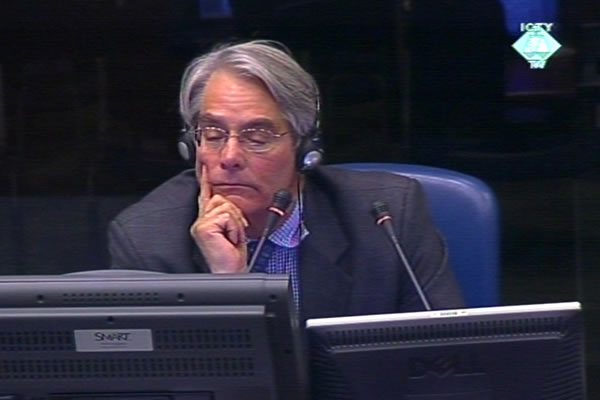Home
WAS GENERAL SMITH ‘FASCINATED’ WITH RATKO MLADIC?
In the cross-examination of former UNPROFOR commander in BH Rupert Smith, the accused Radovan Karadzic claimed that the British general was ‘fascinated’ with the Bosnian Serb military leader Mladic and wanted to ‘defeat and humiliate’ him
 Rupert Smith, witness at the Radovan Karadzic trial
Rupert Smith, witness at the Radovan Karadzic trial According to Radovan Karadzic, British general Rupert Smith arrived in Sarajevo in January 1995 and took command over UNPROFOR ‘intending to end the war’ in Bosnia and Herzegovina. To achieve that, it was necessary to ‘shell Serbs and for the UN to resort to force’.
During General Smith’s term of office, the Bosnian Serbs were indeed shelled. Although the Rapid Reaction Force, whose rules of engagement allowed the use of force, was put under General Smith’s command, General Smith denied he had come to Sarajevo with this intention. Smith repeated that his mandate was to secure supplies of humanitarian aid and provide safety in the protected areas like Srebrenica and Gorazde and the respect of the so-called heavy artillery exclusion zone in Sarajevo, established after the first Markale massacre in February 1994. The Bosnian Serbs’ threats to that mandate – blocking humanitarian convoys, shelling protected areas, pulling heavy artillery out of the collection points around Sarajevo, taking UN staff hostage, and using them as human shields – forced Smith to make sure he would be able to respond to any actions by the Bosnian Serb army, if necessary. After the second Markale massacre on 28 August 1995, it turned out that it was indeed necessary, in Smith’s opinion.
Karadzic contends that this was just a pretext to set in motion a plan for NATO air strikes against Bosnian Serb military targets and to activate the Rapid Reaction Force. Karadzic tried to prove this claim by the fact that on 25 August 1995 – three days before the Markale incident – Smith initiated the withdrawal of a contingent of British ‘blue helmets’ from Gorazde. Smith explained that the withdrawal had been planned a month before, after the UN hostage crisis, when a decision was made to pull out the ‘blue helmets’ from isolated areas in the territory under the control of the Bosnian Serb army.
This explanation didn’t sway Karadzic in his conviction that the Markale massacre was staged to provide Smith with a justification to call in NATO aircraft and use force. The accused didn’t accept Smith’s explanation that two investigations had concluded beyond reasonable doubt that the shell that killed 43 and wounded more than 70 persons had been fired from the Bosnian Serb army positions. Karadzic contested the findings of Smith’s investigations by referring to the claims made by Russian colonel Demurenko and American journalist Binder. According to Demurenko and Binder, the ‘Muslim forces’ fired the fatal shell to cause air strikes against Serbs. Demurenko put forth his theory at the trial of Dragomir Milosevic, former commander of the Sarajevo-Romanija Corps, where he testified as the key witness of the defense. The Trial Chamber rejected Demurenko’s evidence in its entirety, finding that it was proven beyond reasonable doubt that the shell had been fired from the Bosnian Serb territory. General Milosevic was sentenced to 33 years.
Karadzic accused Smith of being ‘fascinated by General Mladic’ and of wanting to ‘defeat and humiliate’ him. This, Karadzic contends, led Smith to order a strike against the village where Mladic’s parents were buried, to show that the general could not protect ‘even the bones of his predecessors’. General Smith denied he was ‘fascinated’ by the Bosnian Serb military commander and his personality. The target in Mladic’s village was a military facility and not the graveyard, Smith explained. ‘If that humiliated Mladic, the only thing Mladic had to do was to stop’, said Smith.
The accused Karadzic continues his cross-examination of General Rupert Smith tomorrow.
Linked Reports
- Case : Karadzic
- 2011-02-09 MLADIC’S INTENTIONS IN SREBRENICA WERE MISREAD
- 2011-02-08 GENERAL RUPERT SMITH: ‘KARADZIC OUT OF TOUCH WITH WORLD’
- 2011-02-03 ‘MAPPING’ THE SNIPER TERROR CAMPAIGN IN SARAJEVO
- 2011-02-11 WHO HAD THE OBLIGATION TO DEMILITARIZE PROTECTED AREAS
- 2011-02-14 EARLY NIGHTFALL IN SARAJEVO
- 2011-02-14 CRISIS STAFFS IN ‘ROUGH AND HARD TIMES’
